Kia EV6 GT-Line AWD review
The EV6 is the most serious electric car yet from Kia. Sure, since 2021 there’s been the Niro EV in Kia showrooms, but being adapted to an ICE platform meant inherent compromises.
The Kia EV6 starts from the outset as an electric car. It sits on the same architecture as the Hyundai Ioniq 5, a platform known as E-GMP, which will also be used to underpin a family of future Kia EVs, including a large SUV called EV9.

TESTED: Kia EV6 Air review: The entry-level EV put to the test
READ MORE: Kia EV6 Australian pricing and specifications confirmed
READ MORE: Smaller battery set for more affordable Kia EV6 … eventually
READ MORE: Only 500 Kia EV6s for Oz in 2022, GT delayed until 2023
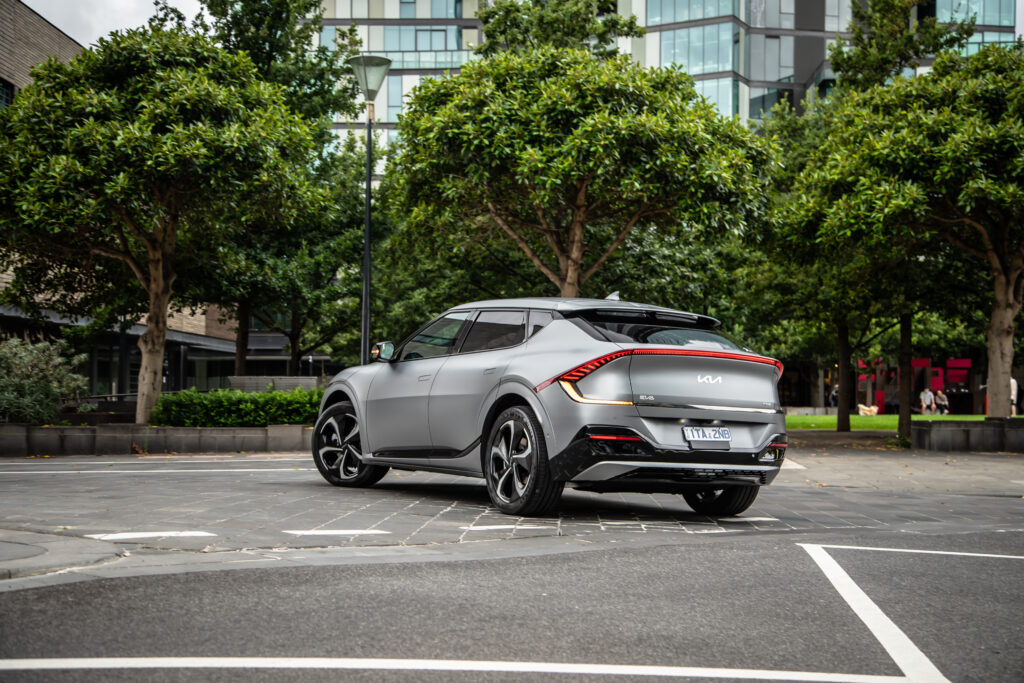
Naturally, the EV6 competes with the Ioniq 5 but also lines up against the Tesla Model 3 and Polestar 2. It will also in some ways compete with the Volvo XC40 Pure Electric and Mercedes-Benz EQA250.
Value
It’s impossible not to make EV6 comparisons with the Ioniq 5, such are the similarities beneath the skin.
In summary, Kia has a more affordable Air model in what is now a three-pronged lineup, but that car gets less equipment. The GT-Line better lines up against the Hyundai for price and equipment; it’s available in rear- and all-wheel drive guises and by late 2022 or early 2023 there will be a high performance EV6 GT available.
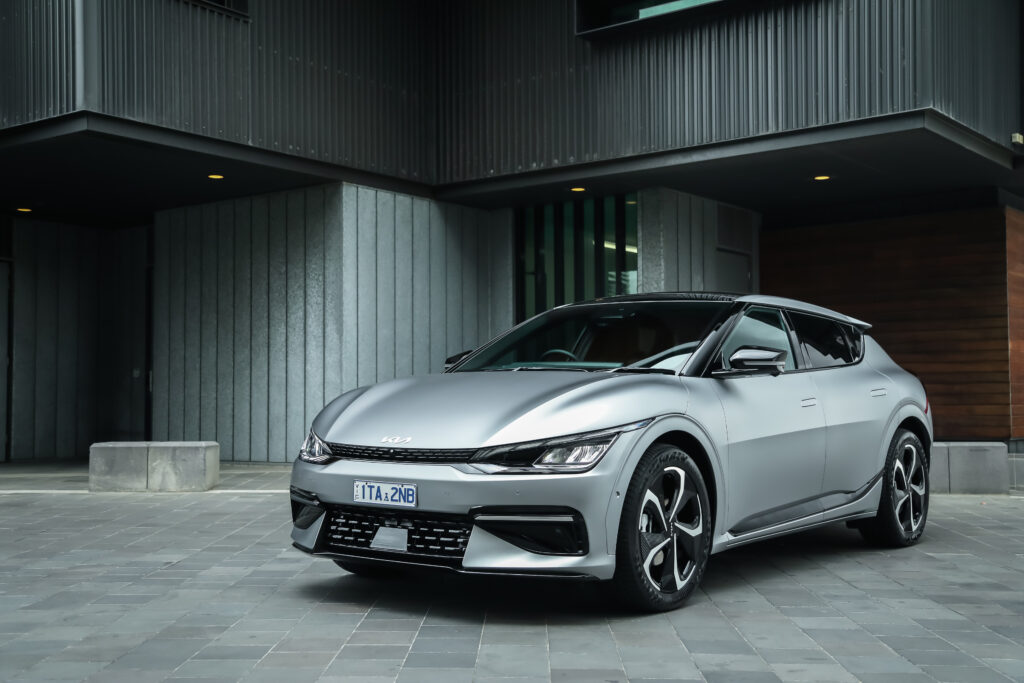
That most affordable EV6 Air starts at $67,990 plus on-road costs. Once you add a couple of grand of dealer delivery it means you miss out on the $3000 rebates available in NSW, Victoria and South Australia. But it is available for stamp duty exemptions, depending on where it’s being registered.
For that you get the longer range 77.4kWh battery (the EV6 is available with a 58kWh battery overseas, something that will eventually be offered here).
The Air comes with 19-inch alloy wheels, smart key entry, wireless phone charging, satellite-navigation, dual-zone ventilation, front and rear parking sensors, autonomous emergency braking, blind spot warning, mirrors that fold when parked, tyre pressure sensors and a 230V powerpoint in the base of the rear seats; it can be used to power anything from camping gear or a computer or even charge another EV (slowly!). There are also twin 12.3-inch displays, the centre one a touchscreen for the infotainment system, which incorporates Apple CarPlay and Android Auto connectivity. No shortage of charging options for devices, either; there’s a USB-A and USB-C port in the front console as well as USB-C ports in the backs of the front seats.
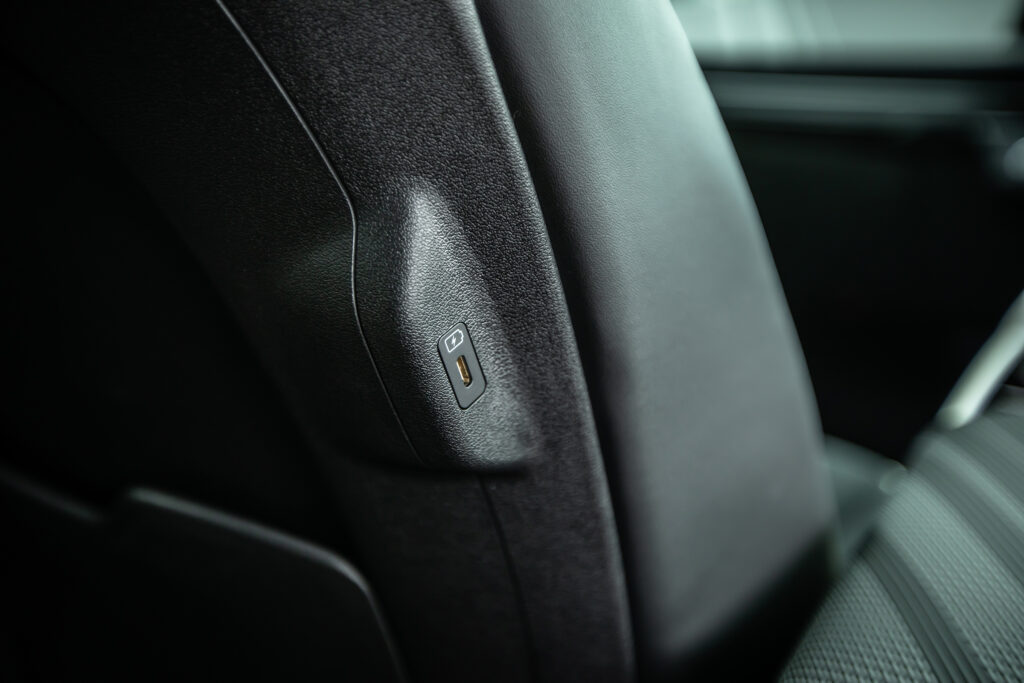
With a focus on sustainability, the Air also has unique finishes and recycled plastics.
The GT-Line, on the other hand, steps up the interior presentation with some fake leather and suede on the seats and interesting patterns on the dash. It’s certainly a classier look inside, although you pay for it, at $74,990 plus on-roads; that means you’ll save some money on stamp duty in some states.
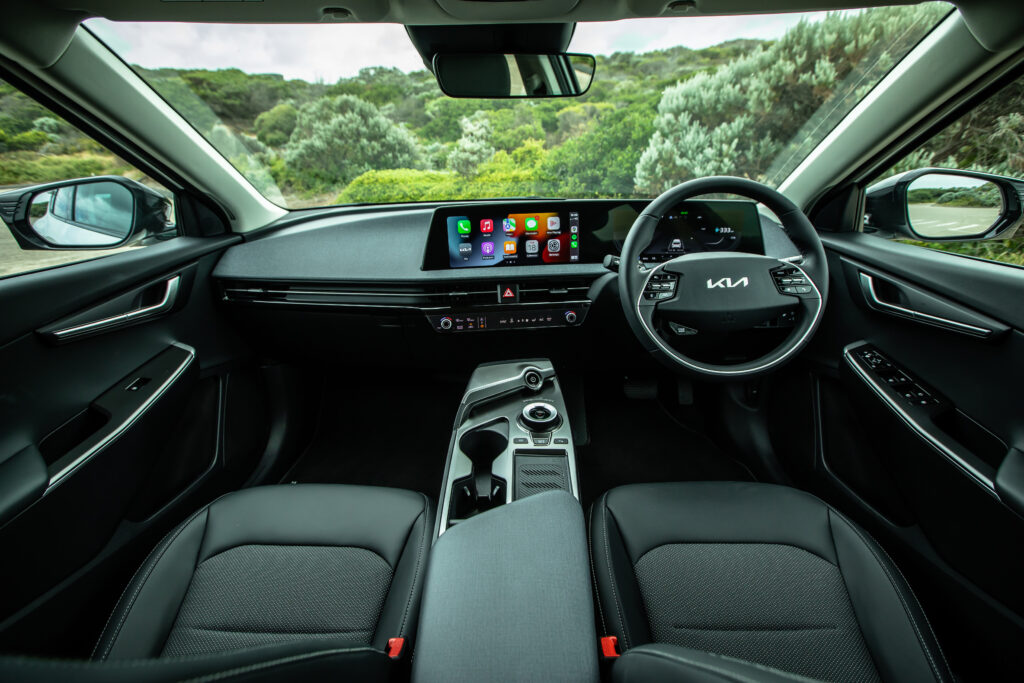
There are also 20-inch alloys, power adjustable front seats, ambient lighting, head-up display, heated and ventilated front seats, heated steering wheel, powered tailgate, 360-degree camera and a 14-speaker Meridian sound system (it’s crisp and clear but lacks the hard-hitting bass of some premium sound system). The dual motor all-wheel drive model also picks up a sunroof.
The GT-Line also gets styling tweaks, including body-coloured wheel arch surrounds and side skirts (on the Air they’re black) and unique bumpers front and rear.
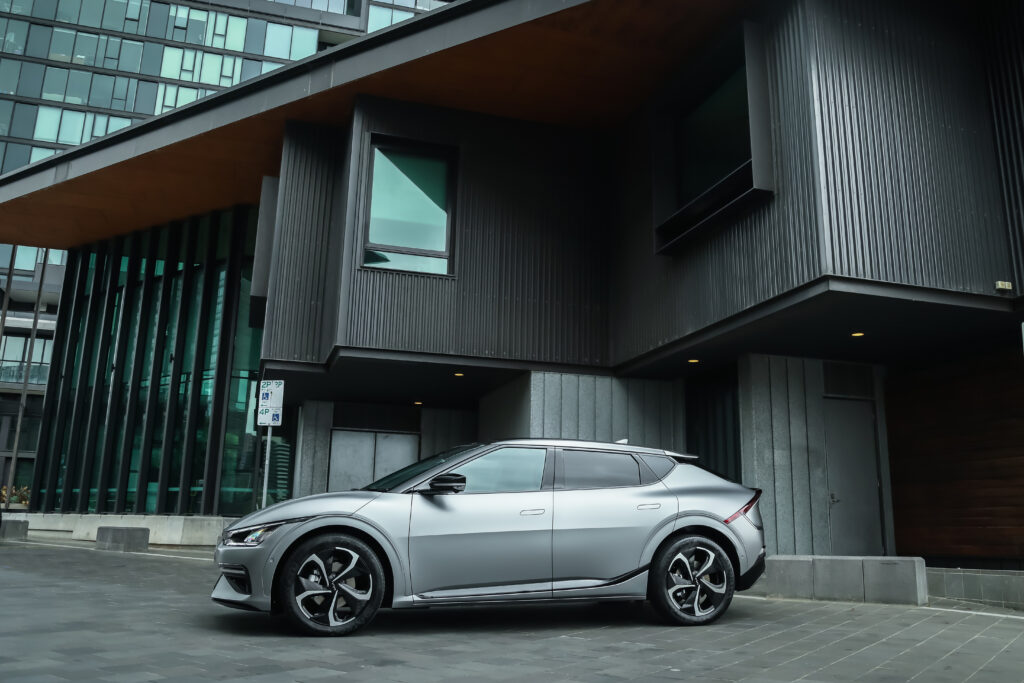
And at the top of the EV6 tree is the GT-Line AWD. As well as an additional motor up front – creating an all-wheel drive system – it gets a sunroof as part of the $81,990 plus on-road costs ask.
There’s one thing missing on all EV6s for now: an associated app. So-called Kia Connect is on the way, but it won’t be available until about 2023, leaving early cars without the ability to perform basic functions remotely (lock or unlock the doors or activate the ventilation system).
Inside
The EV6 is officially classified as a large SUV due to its exterior dimensions and long wheelbase (at 2900mm it’s 50mm longer than a Toyota LandCruiser).
While it doesn’t have seating for seven (the EV6 only has two rows of seats, for five in total), there’s loads of space front and rear.

Those in the back will notice the high-ish floor that can have the knees of taller people slightly higher than they may like, but it’s compensated for by plenty of leg room. Air vents on the outer pillars provide ventilation.
Up front, there’s similarly good space as well as loads of storage areas. The long and broad centre console gobbles up phones and smaller bags, while the unusually deep glovebox also does its best swallowing everything from tablet computers to small bags. Throw in decent door pockets and other hidey holes and it’s a very useful cabin.
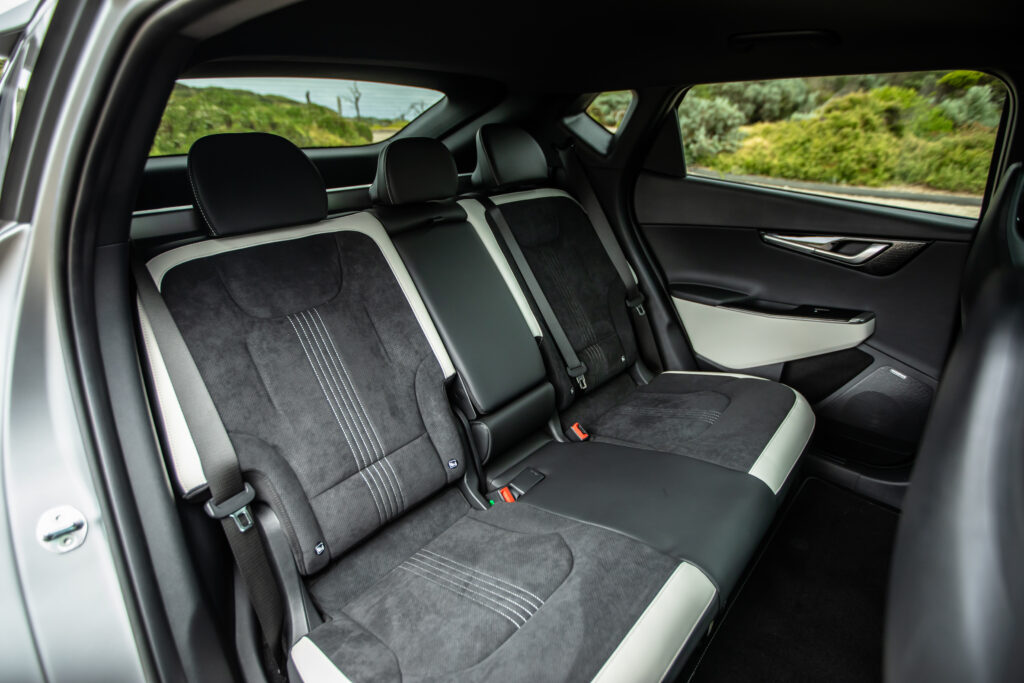
The GT-Line AWD’s sunroof eats into head room for the driver, something that dissipates for the Air and GT-Line single motor, each of which does without the glass roof.
There’s ample adjustability to the seating position, with the GT-Line’s seat memory settings adding convenience.
We’re not sold on the upper section of the front seats. Lateral support and overall torso comfort are fine, but chunky headrests take some acclimatisation.
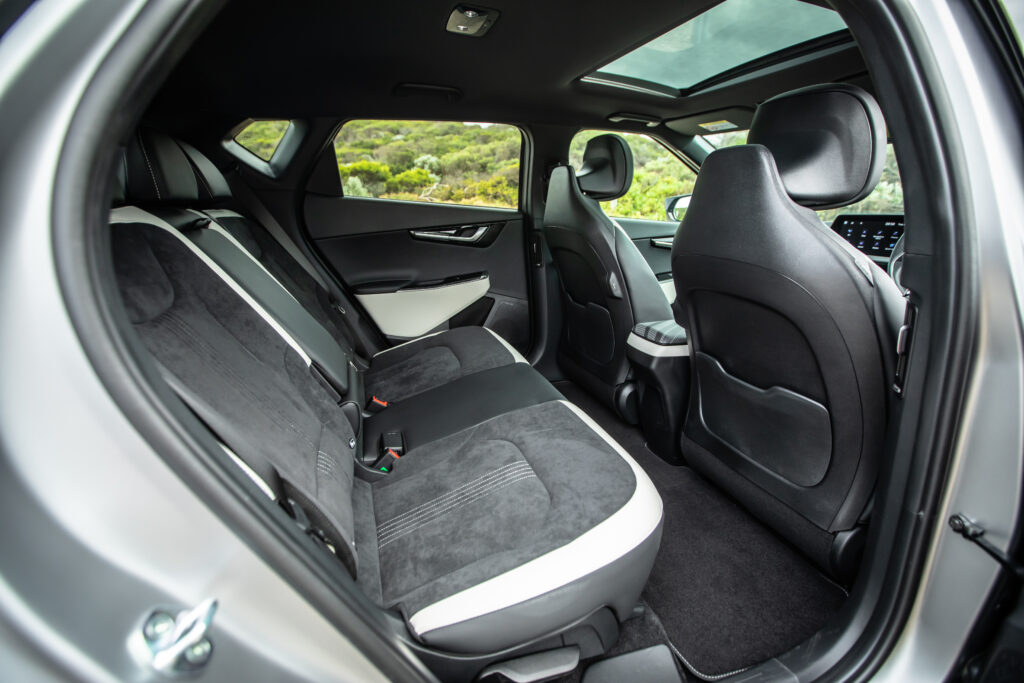
No issues with the mix of tech, although I’d prefer an option to centre the digital speedo within the 12.3-inch instrument cluster. Its positioning off to the left sometimes gets foiled by the steering wheel.
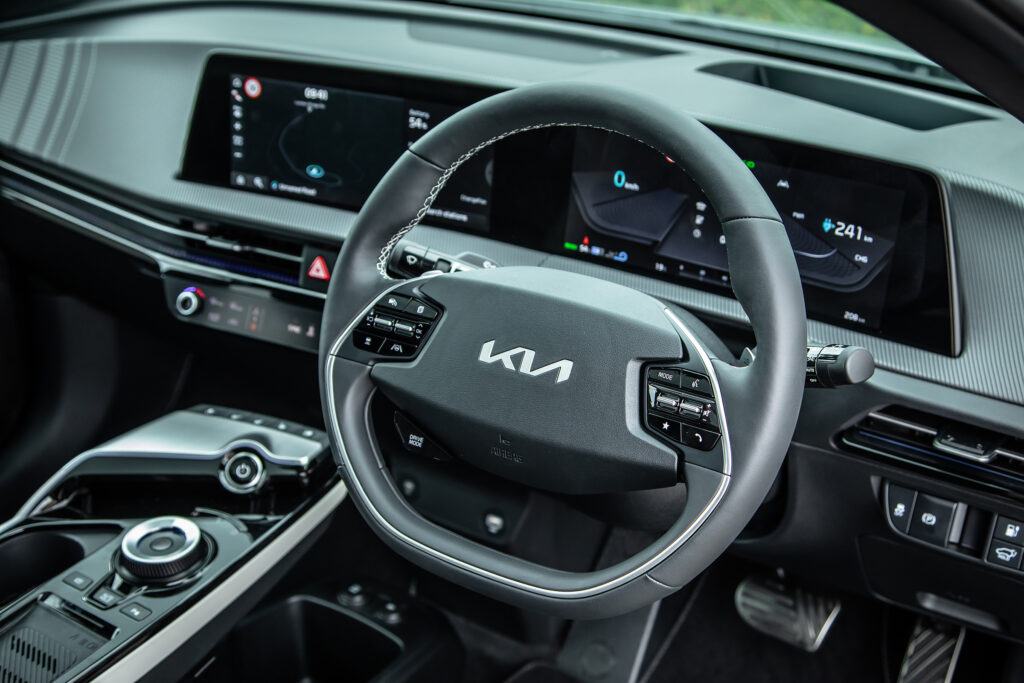
The centre touchscreen of the same 12.3-inch diagonal is easy to navigate and nicely integrates the Apple CarPlay and Android Automotive connectivity functions.
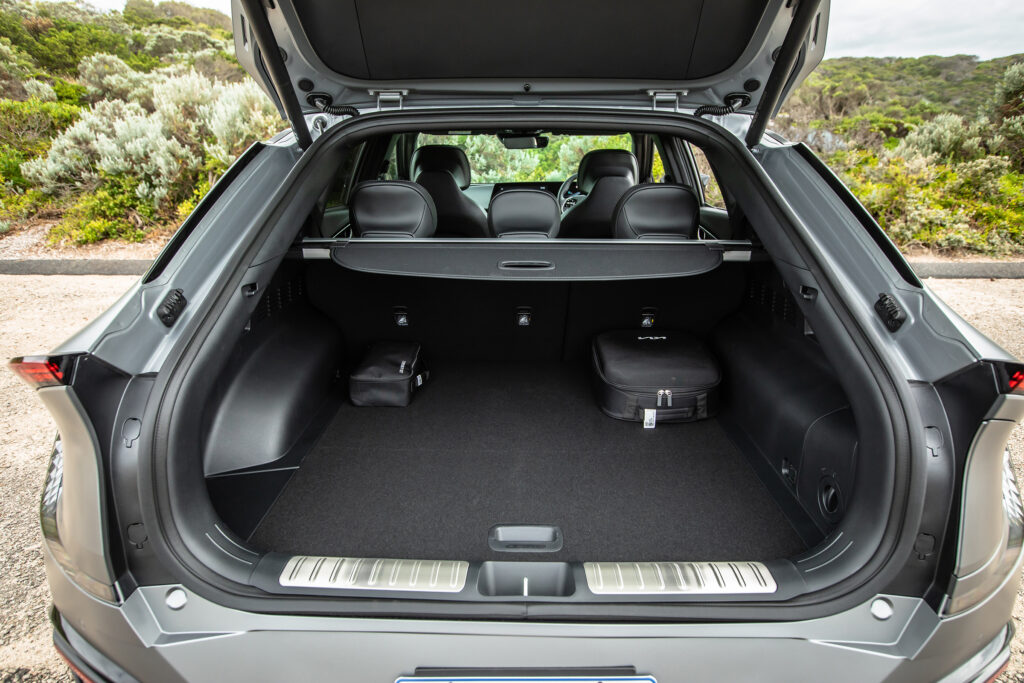
The boot provides 480 litres of capacity (10L less than the Air model due to the subwoofer beneath the boot floor) and there’s a 60/40 split-fold.
There’s also a slender 20L front boot – or “froot”, as Kia calls it – which might look after some valuables or charging cables (rear-drive models get a deeper 52L cavity up front).

Performance and efficiency
Two of the three EV6 models get single electric motor driving the rear wheels. It makes 168kW and 350Nm and will get you to 100km/h in 7.3 seconds. It’s surprisingly punchy, even on the open road. For many buyers it will easily suffice.
But it’s the AWD we’re testing here. The addition of another motor up front takes those combined outputs to 239kW and 605Nm. At the same time the 0-100km/h time drops to 5.2 seconds.
So it’s a lot quicker, something you notice with any prod of the throttle.

It doesn’t have the brutality of some EVs in the way it launches from a standstill (that’s likely being reserved for the EV6 GT that should start arriving late in 2022 or early 2023), but there’s more than enough enthusiasm.
At country road speeds, too, the EV6 AWD always has plenty in reserve for a slick overtake or to punch out of a corner.
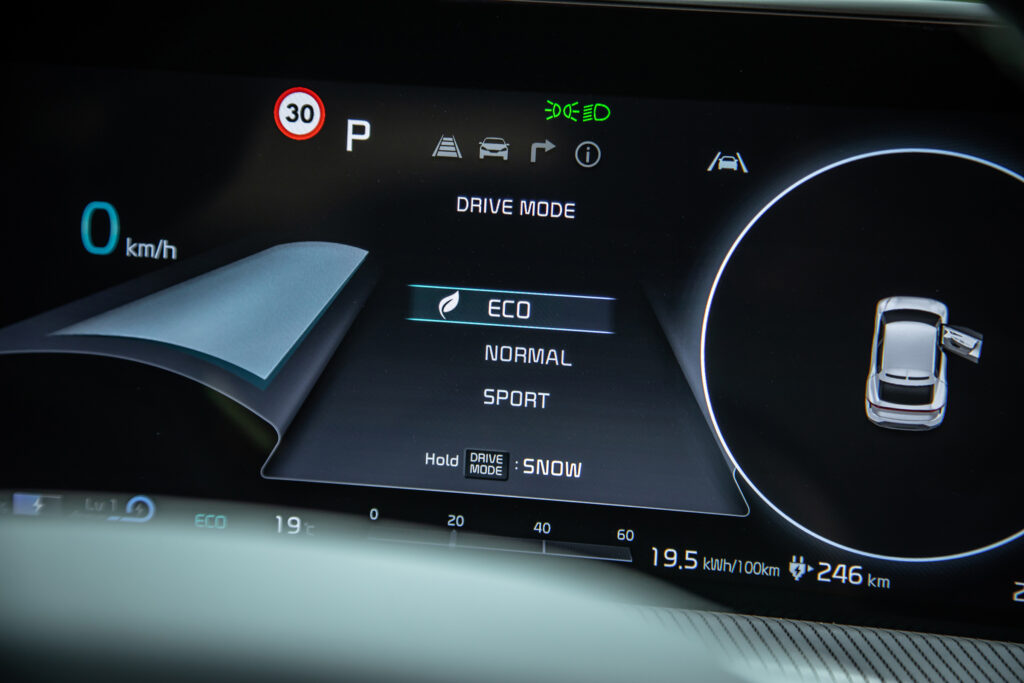
A drive mode button on the steering wheel allows you to alter the throttle response, which gets crisper in Sport while also intensifying the fake sound. Dial up Eco and it not only softens responses but also lowers the overall power, dulling it back so it’s closer in outright punch to the rear-drive EV6 models.
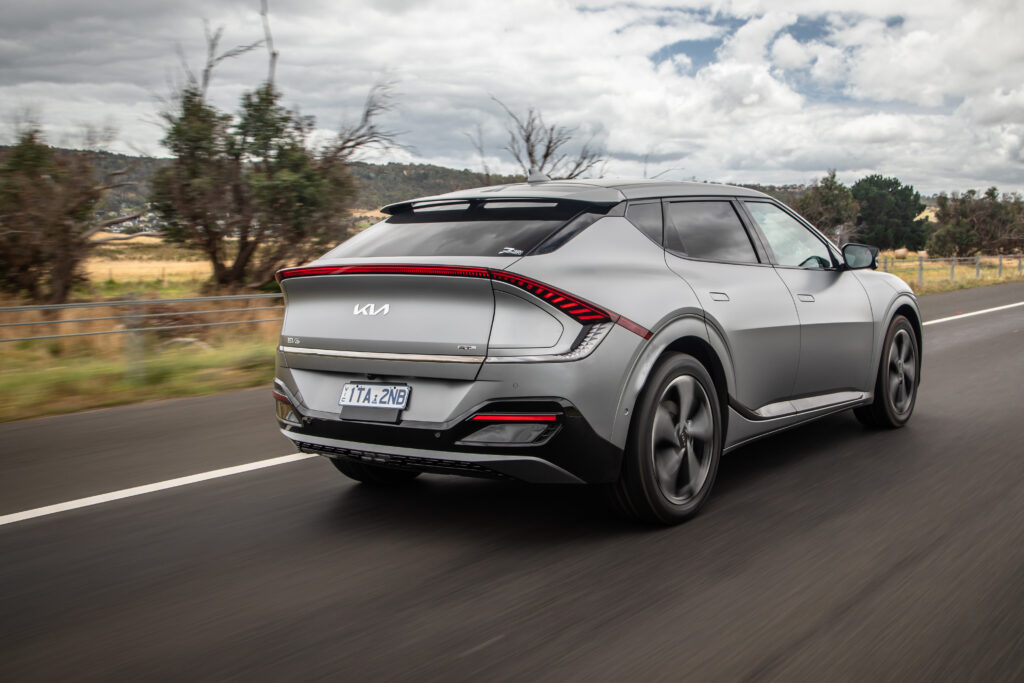
Claimed electricity use for the dual motor AWD is 18.0kWh per 100km. Unsurprisingly we used more than that in a drive that included more high-speed country driving.
The AWD’s claimed WLTP range is 484km and our spirited drive suggests something north of 400km is thoroughly achievable.
The head-up display is a handy addition, at least if you’re not using polarised sunglasses (which block it completely), and is positioned nicely in the driver’s line of sight.
For those who want to tow, it’s designed to lug up to 1600kg (with a maximum towball download of 100kg), something we didn’t test.
Charging
Despite sharing the same architecture as the Hyundai Ioniq 5, the EV6 gets a bigger battery: 77.4kWh versus 72.6kWh.
That means an impressive WLTP range of 484km.
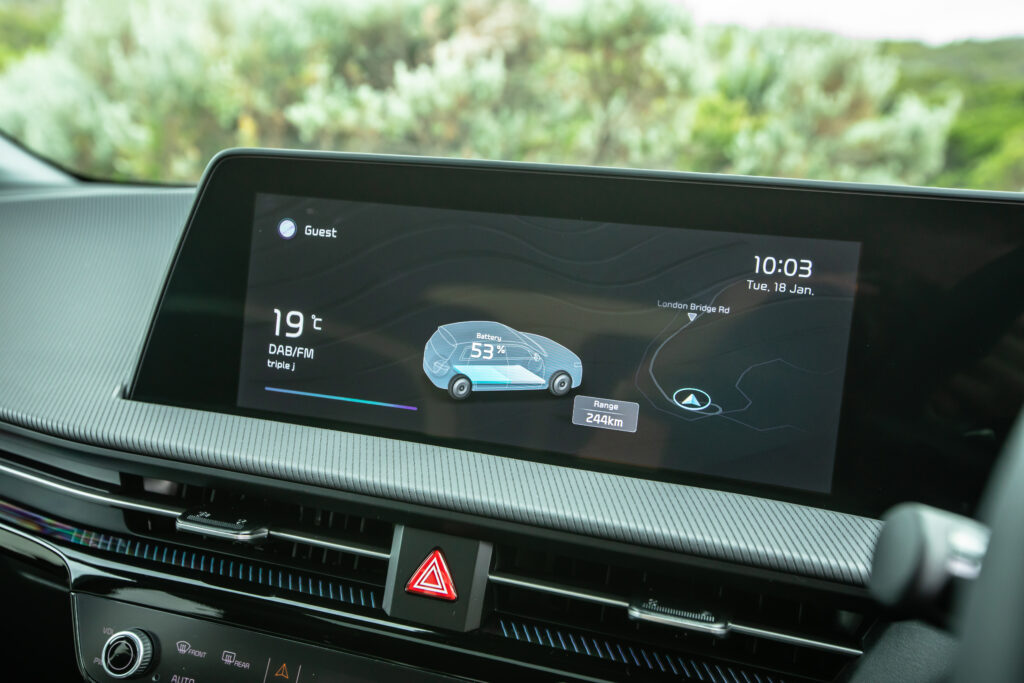
There’s lots of mention of 350kW chargers with the EV6. But the short story is it can’t accept 350kW of charge.
But with a maximum DC charging rate of 240kW it can benefit from the 800V functionality of those 350kW ultra-rapid chargers.
All of which leads to very fast charging, as we experienced in a charging race between the Hyundai Ioniq 5, Porsche Taycan and Audi e-Tron. A 10-80 percent charge takes about 18 minutes; in the rear-drive Air that’s enough for about 350km of range, but in the GT-Line AWD we’re testing here uses more electricity so it amounts to something approaching 300km of real-world range.
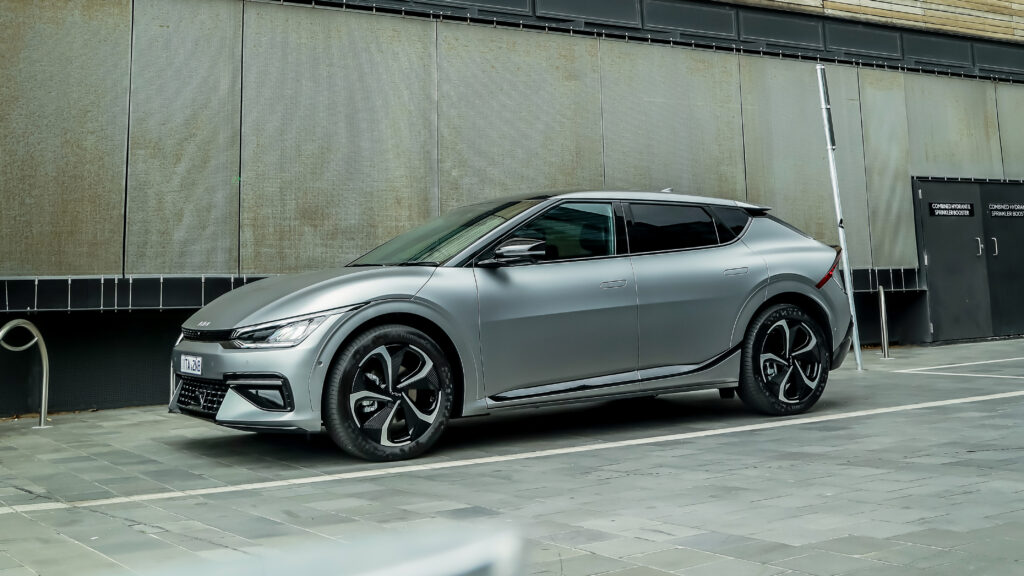
AC charging is done at up to 10.5kW, so a full charge would take around 7.5 hours.
If you’re using a regular powerpoint then that full charge translates to about 34 hours.
Ride and handling
One big differentiator with the GT-Line version of the EV6 compared with the entry-level Air is its wheels and tyres. It rides on 20-inch rims (up from 19s) and has EV-specific Continental tyres.
They’re a nice match, hanging on resolutely through sweeping corners and adding to the sense of competency.
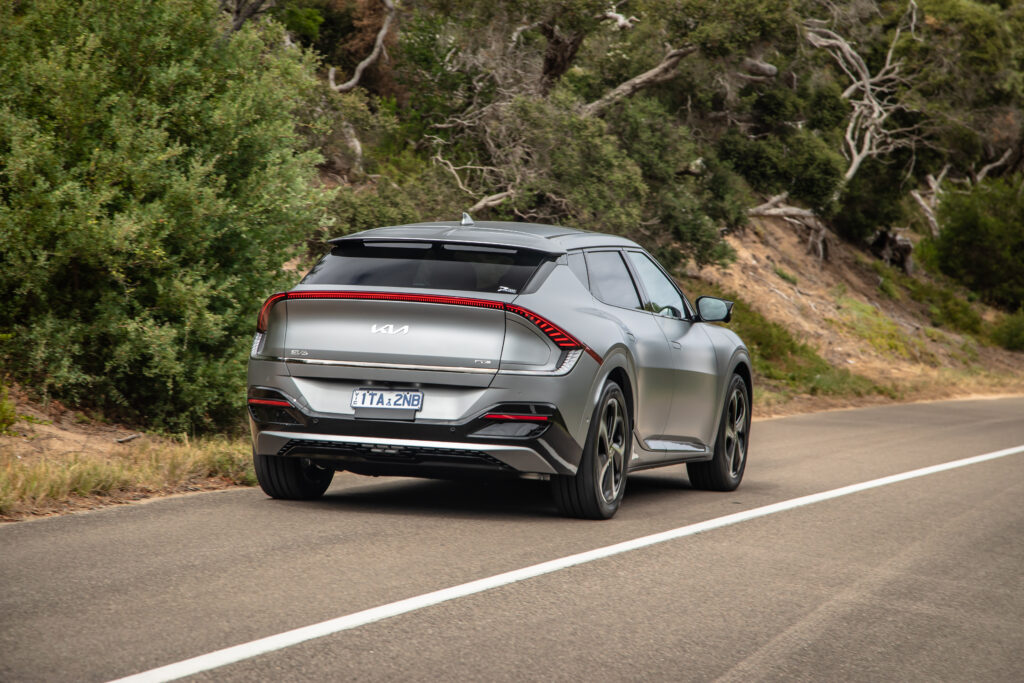
Lift the pace and the EV6 is more than capable, albeit with limitations that come down to physics.
In GT-Line AWD guise there’s 2105kg to coax around bends and once you step things up it’ll occasionally trigger the stability control as it nips and tucks some dalliances with the limits of adhesion.
It’s generally very predictable, ultimately leaning on its nose as the front wheels flow into understeer.
Occasional inconsistencies in the steering are a rare blemish on some impressive dynamic talent.
That talent is amplified in the control over bumps. During our drive around Canberra it was occasionally tasked with some big hits that it handled surprisingly well, settling the weighty body swiftly.
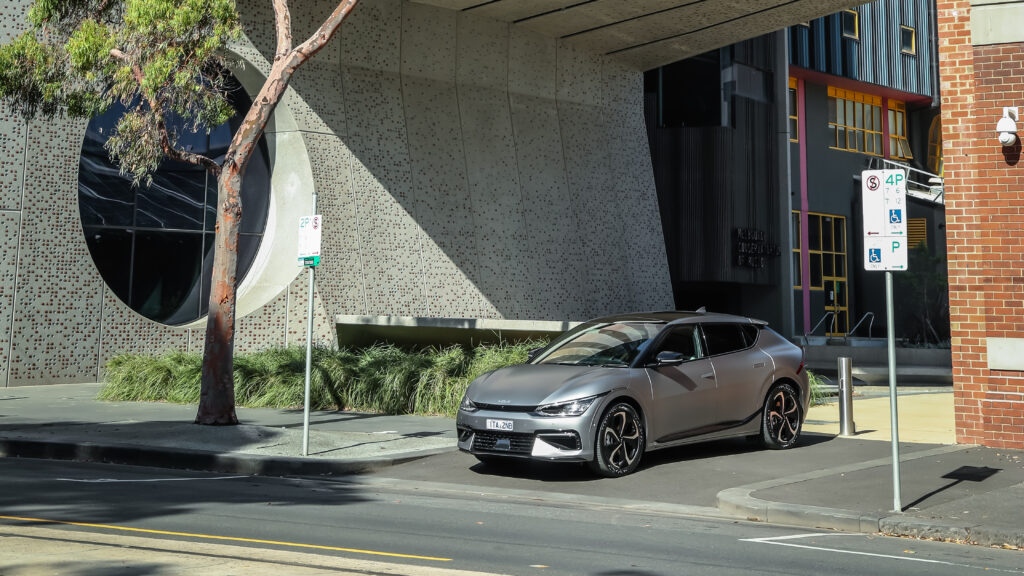
Yet it also deals admirably with chatter bumps that can otherwise take the edge of comfort.
It’s not perfect, and there are times at suburban speeds when the occasional sharp edge takes the gloss of the ride. But for a sizeable all-rounder that can kick up its heels on a snaking strip of bitumen the EV6 does an impressive job.
Talking point
Like the Ioniq 5, the EV6 has a vehicle to load function. There’s a powerpoint near the floor between the rear seats that can supply up to 3.6kW of 230V electricity.
So if you need to power some camping gear or charge your laptop it can easily accommodate.
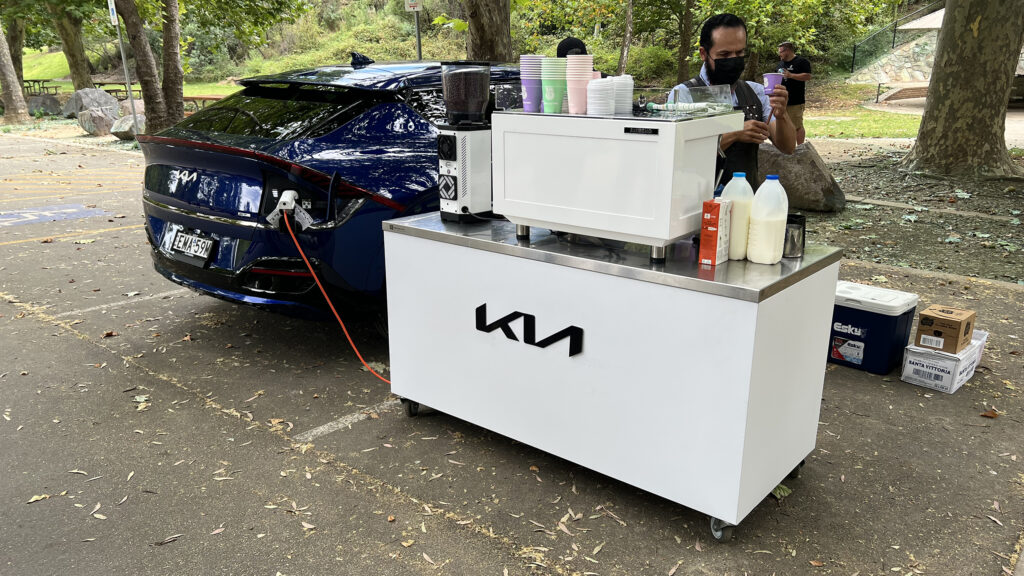
In the GT-Line we tested there’s also an adaptor that plugs into the charge port, providing a second powerpoint plug for devices – it can even power a coffee cart!
You can even charge another EV, although with a maximum of 3.6kW it’ll be a leisurely top-up.
Safety
All EV6s come loaded with active and passive safety gear. There are side airbags protecting the heads of each outer occupant as well as forward-facing airbags up front. Plus there’s a centre airbag between the front seats to prevent head clashes.
A forward-facing radar and camera also provide autonomous emergency braking functionality, while also providing junction assist to warn of other cars coming into an intersection. Plus there’s a driver attention warning system.
Rear-facing radar helps with rear cross traffic alert and blind spot warning, while also adding the safe exit assist functionality.
Verdict
There’s plenty to like with the Kia EV6. It’s spacious, loaded with tech and leverages the benefits of starting with a dedicated EV architecture. The driving range is also a win and helps offset a price tag towards the pointy end of the mainstream EV offerings.
Local suspension tuning has created an EV that is among the best driving of the sub-$100K brigade, nicely blending athleticism with everyday comfort.
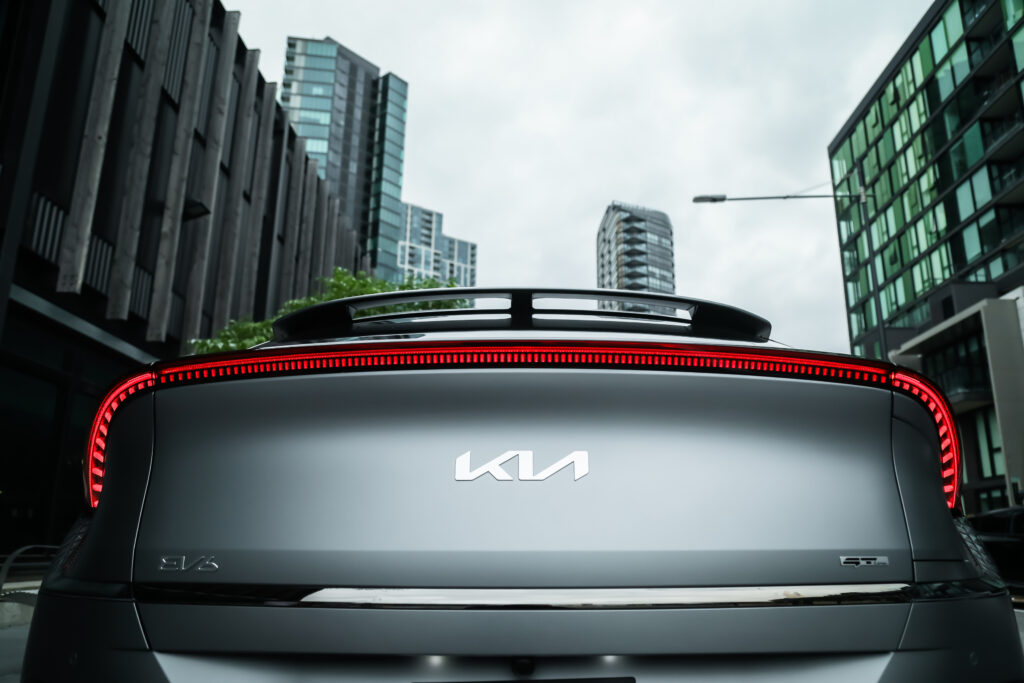
All of which adds up to an electric car that should have little issue shifting the limited supply in the short term.
It also sets a solid template when Kia eventually brings in more affordable variants, something that could happen as soon as 2023.
Kia EV6 GT-Line AWD specifications
Price: $81,990, plus on-road costs
Basics: EV, 5 seats, 5 doors, crossover SUV, AWD
Range: 484km (WLTP)
Battery capacity: 77.4kWh
Battery warranty: 7 years/150,000km
Energy consumption: 18.0kWh/100km
Motors: 1 front and 1 rear, combined 239kW/605Nm
AC charging: 10.5kW, Type 2 plug
DC charging: 240kW, CCS combo plug
0-100km/h: 5.2 seconds

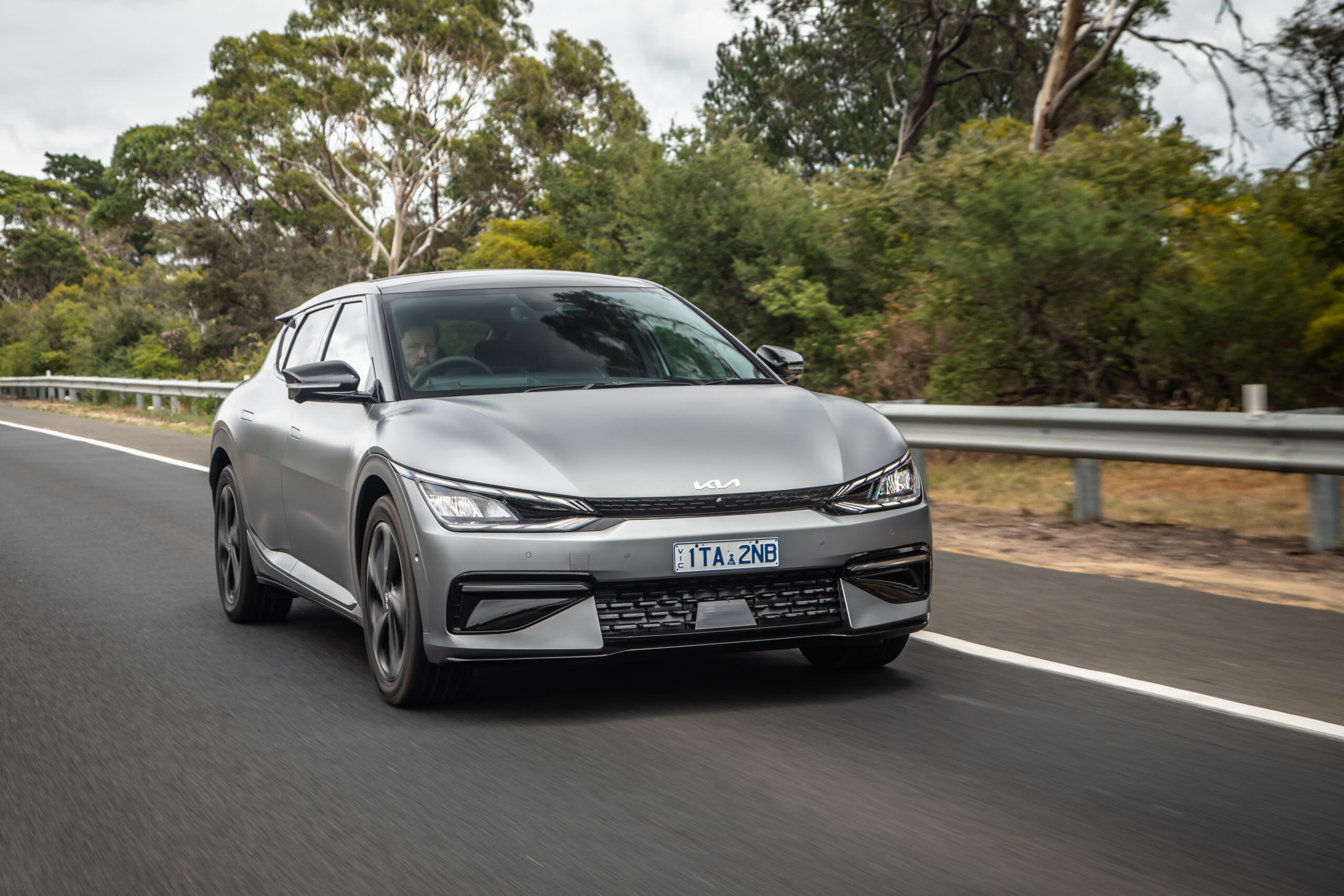
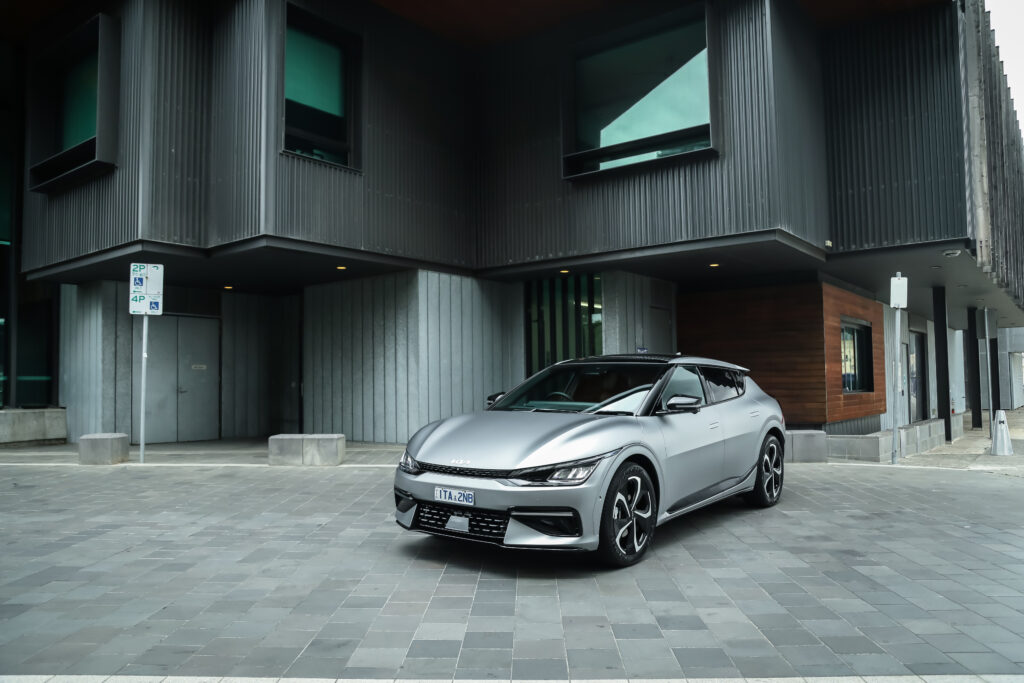
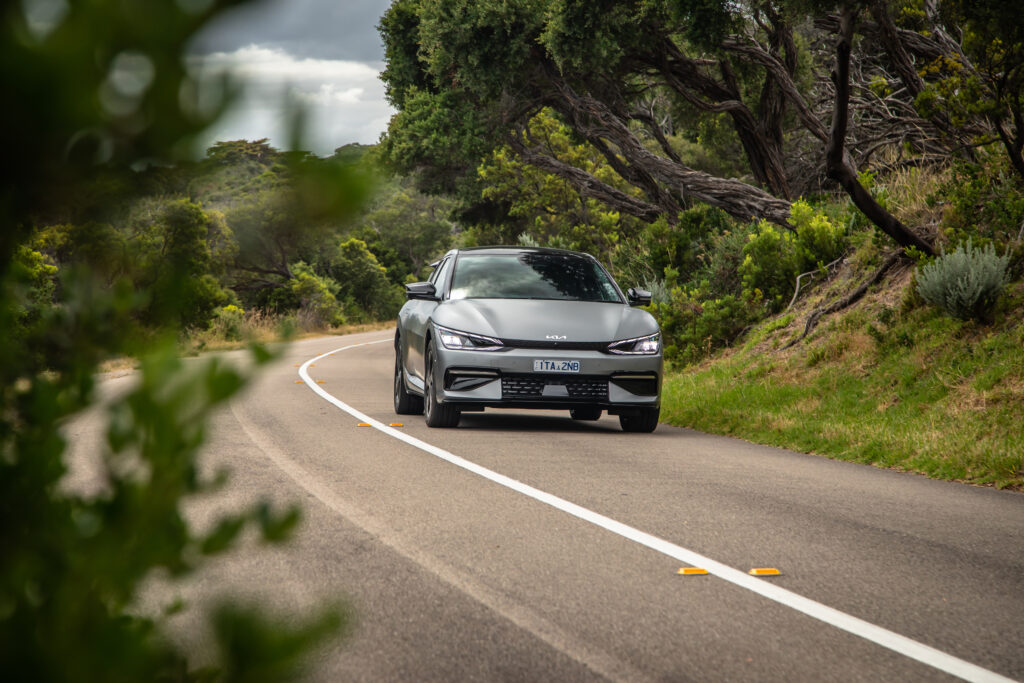
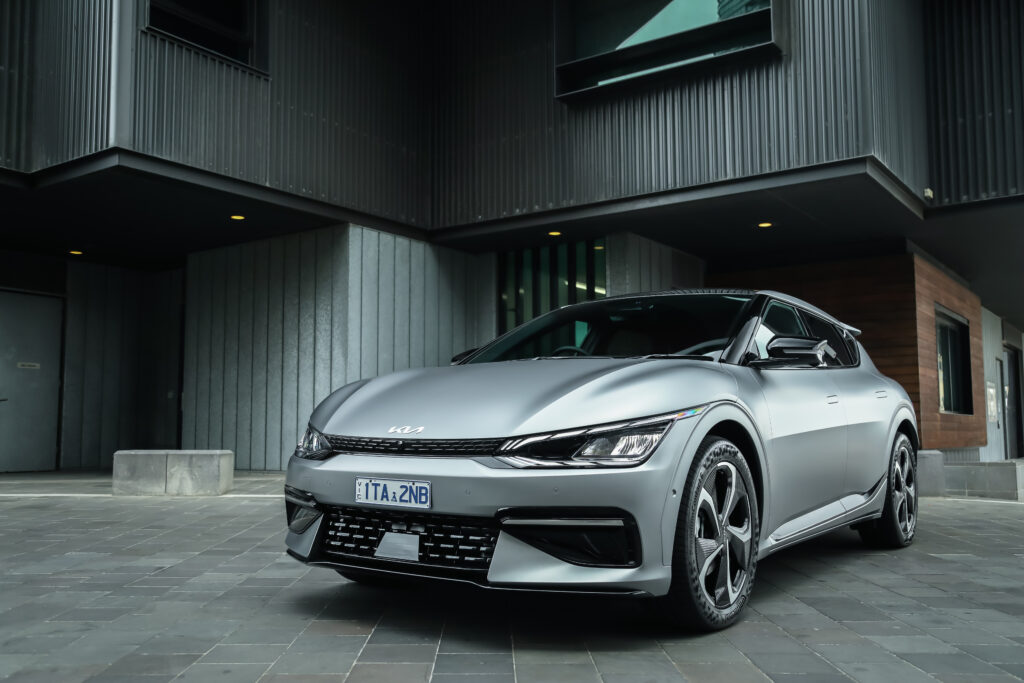
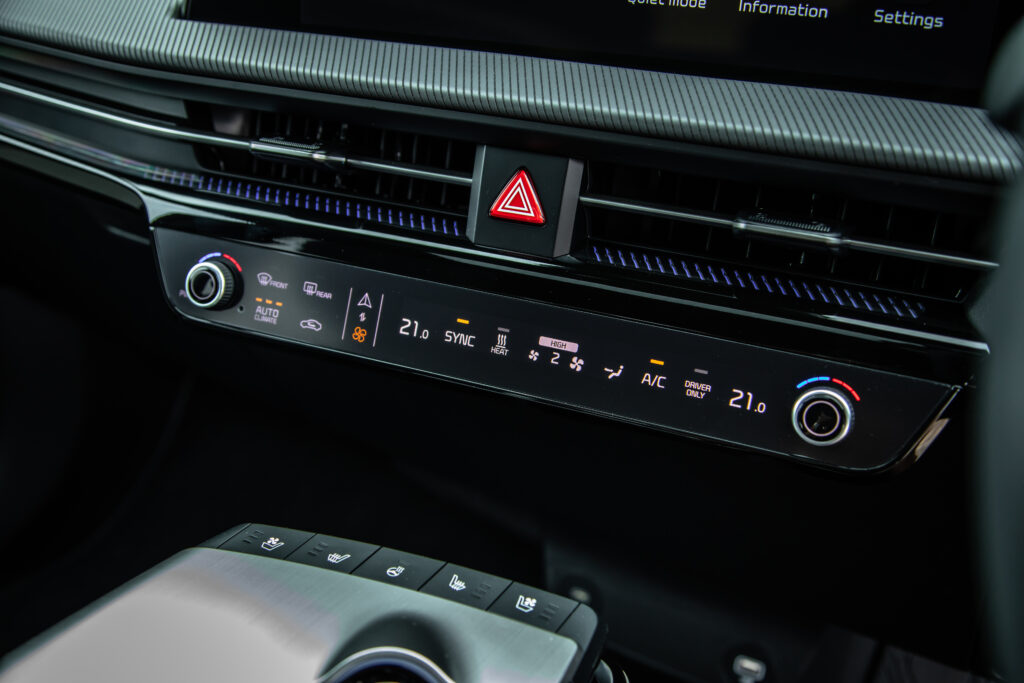
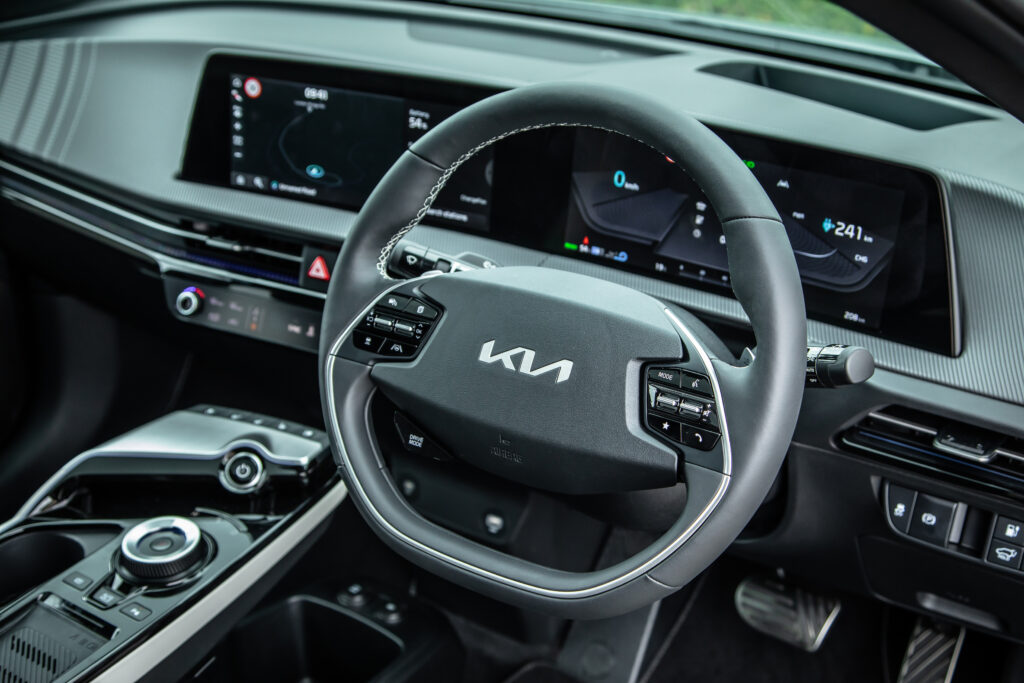

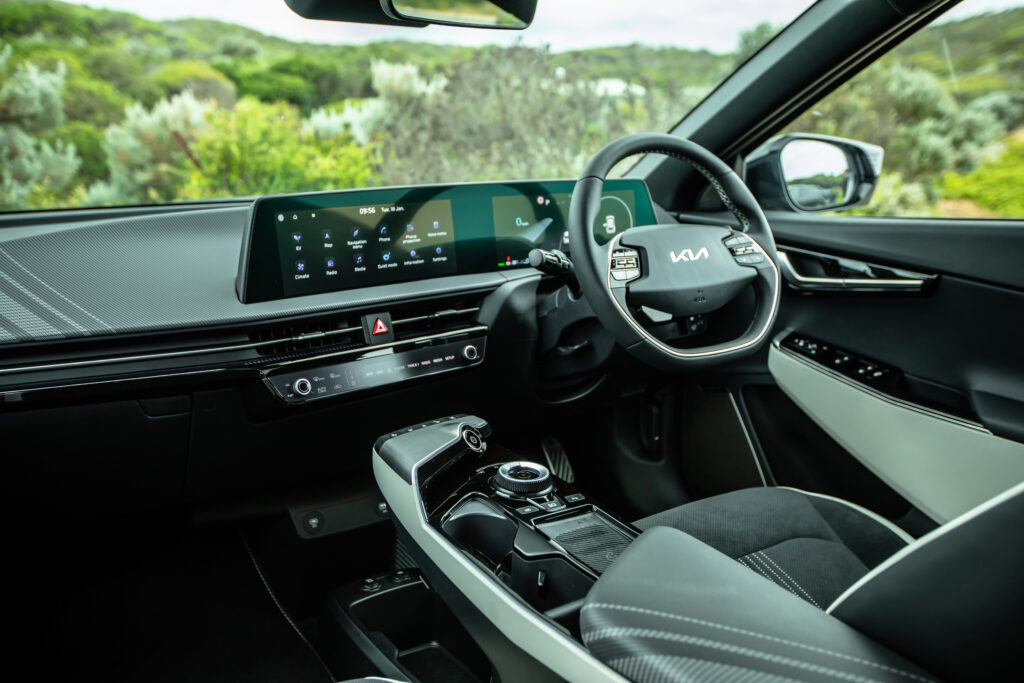
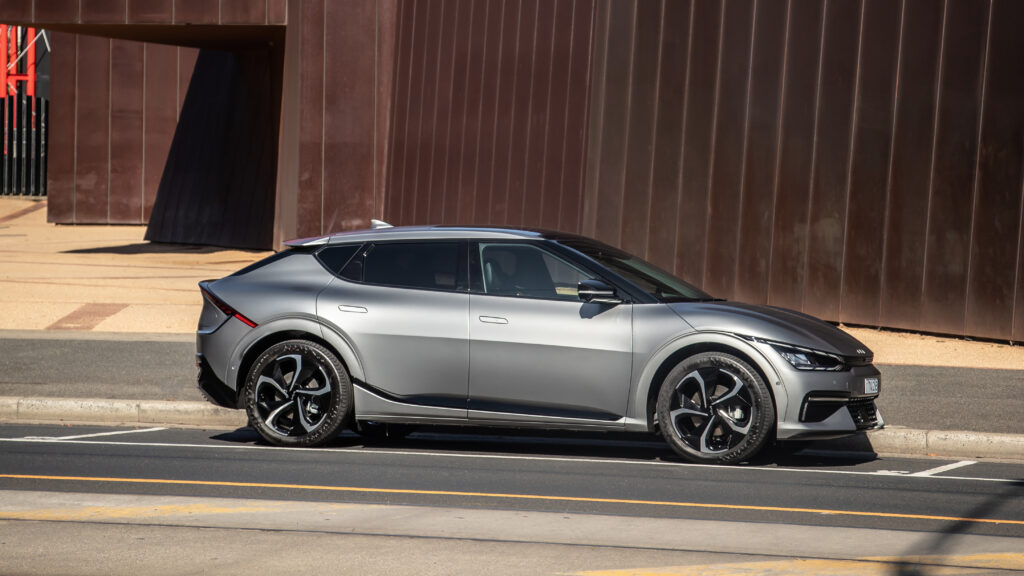
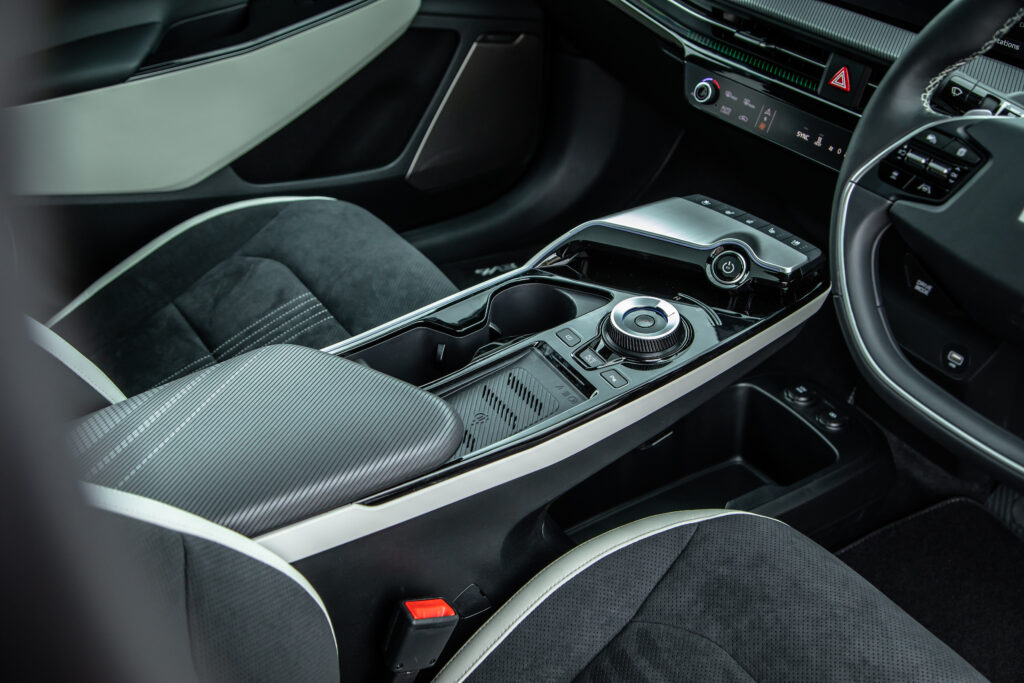
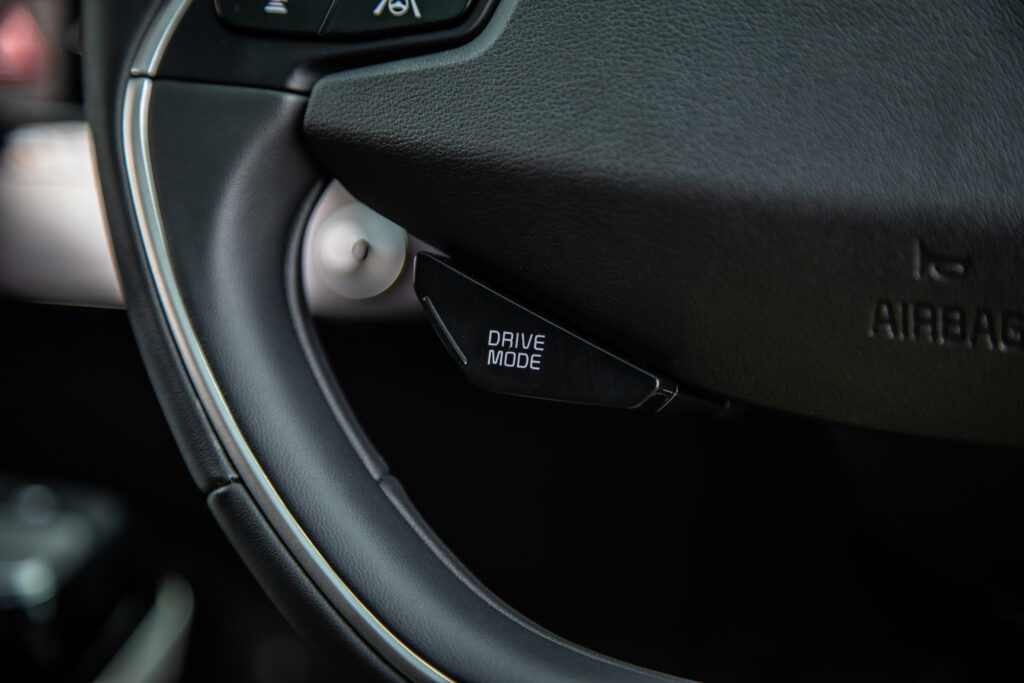
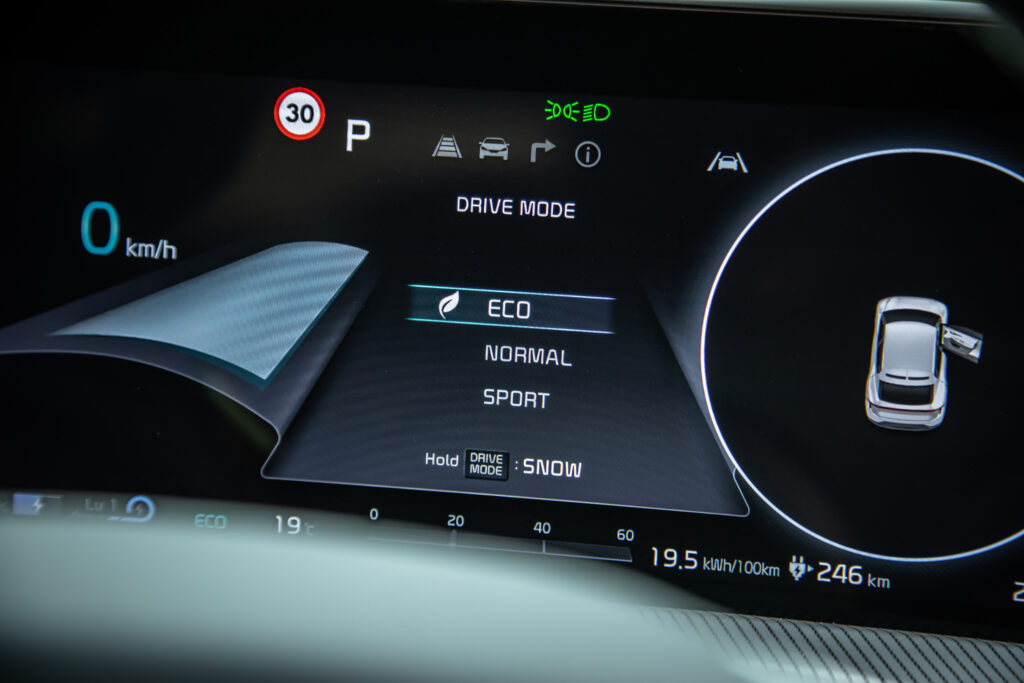
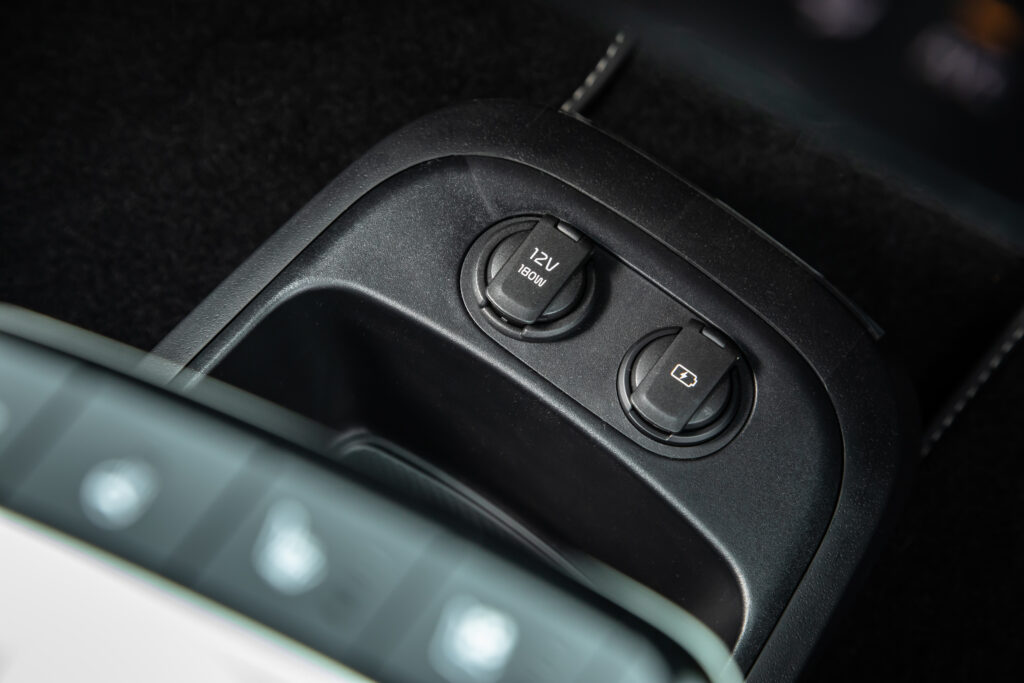
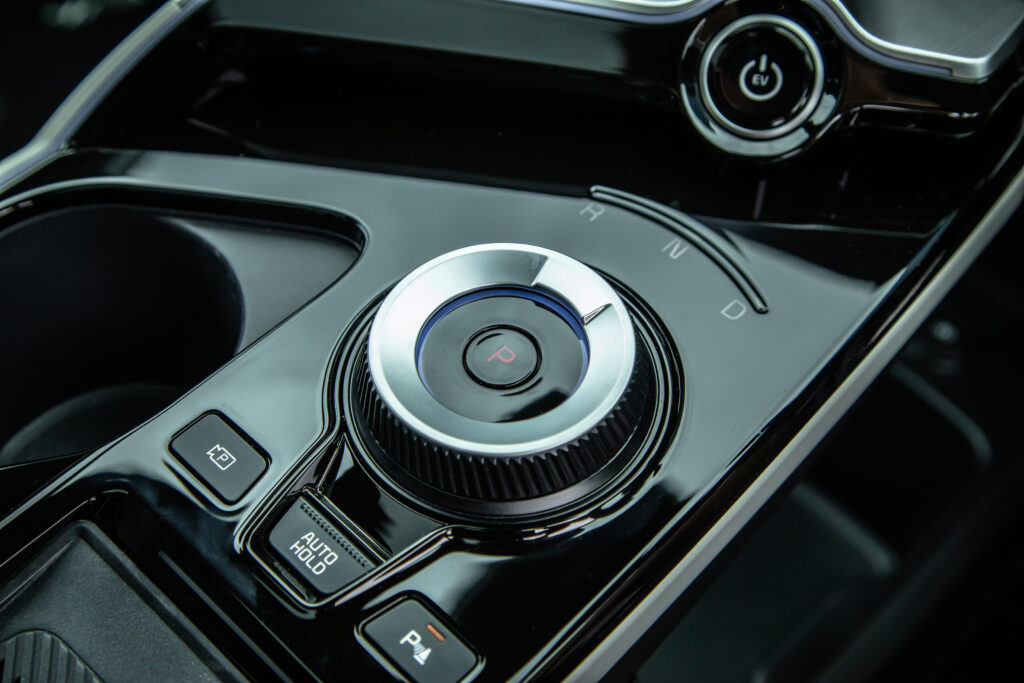
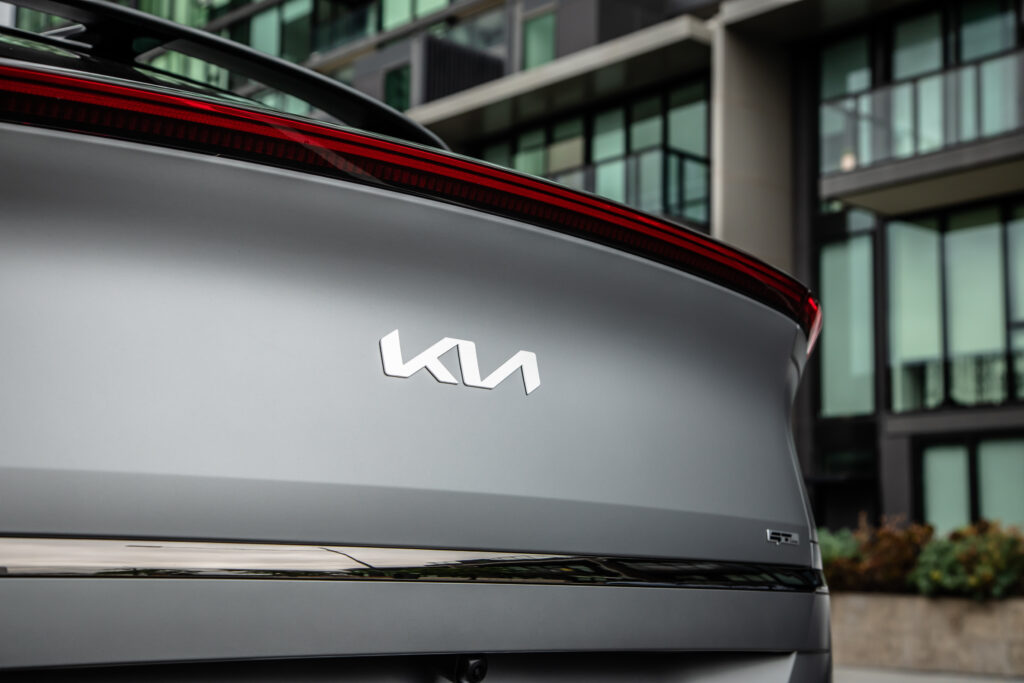
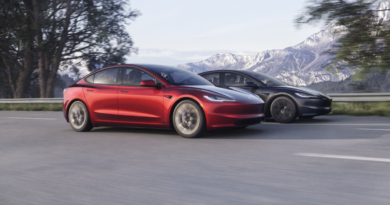
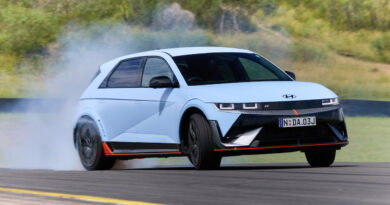
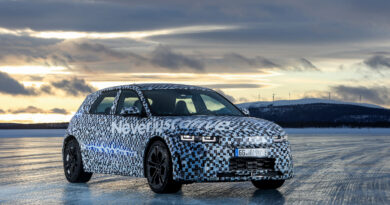
Nice write up. It’s a good looking, and performing car.
Although for the price you’d think they’d fit rear number plate on straight! 🙂
Great review
I am next in line from my EV6 AWD GT line in Melbourne.
Glad you picked up the Kia Connect issue. Will cars shipping now be able to be retrofitted? Assume it needs a SIM chip and a telco deal…surely not that hard?
Also no charging deal like US and UK…and Lexus in oz
I don’t think the connectivity can be retrofitted but will confirm. And no, there’s no charging deal in Australia. For now it’s only luxury brands that have done that.
Confirming that Kia Connect cannot be retrofitted.
Frustrating. Year another car that I would like to buy, but can’t even see or purchase.
The most expensive consumer good I will ever buy, and I’m expected to sign a contract without delivery dates ( but at least 6 to 12 months) with no guarantee of what features I will actually get delivered, no compensation for missing features, no guarantee of delivery by xx /xx in the contract ( drop dead date). Basically a one sided contract and a blank cheque. And this with a car industry who have exhibited time and again cannot be trusted. Forget it.
We’re holding on to our 2014 Octavia Rs waiting to buy an EV. Looks like it’s going to be either the EV6 GT or the Ioniq 5 which might be available in 2024 if we are prepared to order far enough ahead without actually getting to try the model we want. The Zeekr 001 also looks good but who knows if we’ll even get a chance to buy one here in backwater OZ. I had a look at the Polestar 2 but their option packs are standard on other cars and they want $1200 for a charging cable?? I really don’t like being fleeced